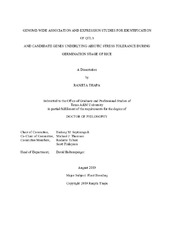| dc.description.abstract | Rice is one of the most important cereal crops feeding more than half of the world’s population. Due to extreme climatic condition, different abiotic stresses like hypoxia stress and chilling stress have been the biggest threat to rice production. Direct sowing method is the most preferred way of planting in Asian countries and in U.S. due to the lower cost of planting and less labor requirement. The major challenge associated with direct sowing is flash flooding that can happen immediately after sowing due to unpredicted rainfall. In this study, we evaluated more than 250 rice accessions belonging to different groups of rice for various traits related to chilling tolerance and hypoxia tolerance during germination stage. Compressed Mixed Linear Model (CMLM) of GAPIT was used to conduct GWAS analysis for the identification of QTLs. From the GWAS study conducted for chilling stress tolerance, we identified 41 QTLs associated with different chilling indices like low temperature germinability, germination index, coleoptile growth under cold condition, plumule length at 4 d recovery, and plumule growth rate after cold germination. Out of 41 QTLs identified in the whole panel, 14 QTLs were potentially colocalized with known genes/QTLs and 27 QTLs were found to be novel. From the GWAS analysis of hypoxia stress tolerance traits, there were 24 significant SNPs identified to be associated with different traits measured under hypoxia stress.
Out of the 24 significant SNPs discovered in the whole panel, 11 QTLs were found to be potentially colocalized with previously identified candidate genes underlying flooding tolerance mechanism in rice. From the phenotypic evaluation of the whole panel for chilling stress tolerance and hypoxia stress tolerance, two lines with contrasting phenotypes under each stress condition were selected and used for global gene expression analysis. The results of these transcriptomics studies have provided new insights of underlying biological processes, molecular functions and cellular components related to the phenotypic differences of the contrasting lines. The findings of our study will help in identification of promising candidate genes underlying hypoxia stress and chilling stress tolerance and would eventually assist rice breeding program to develop improved tolerant rice cultivars. | en |


